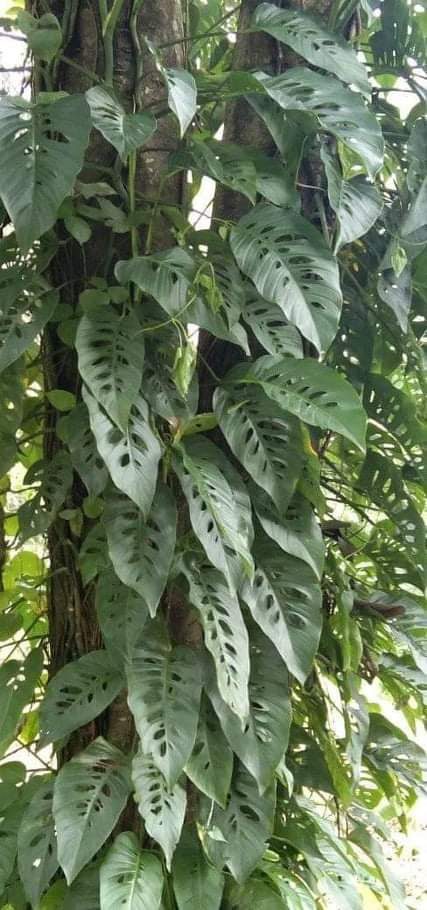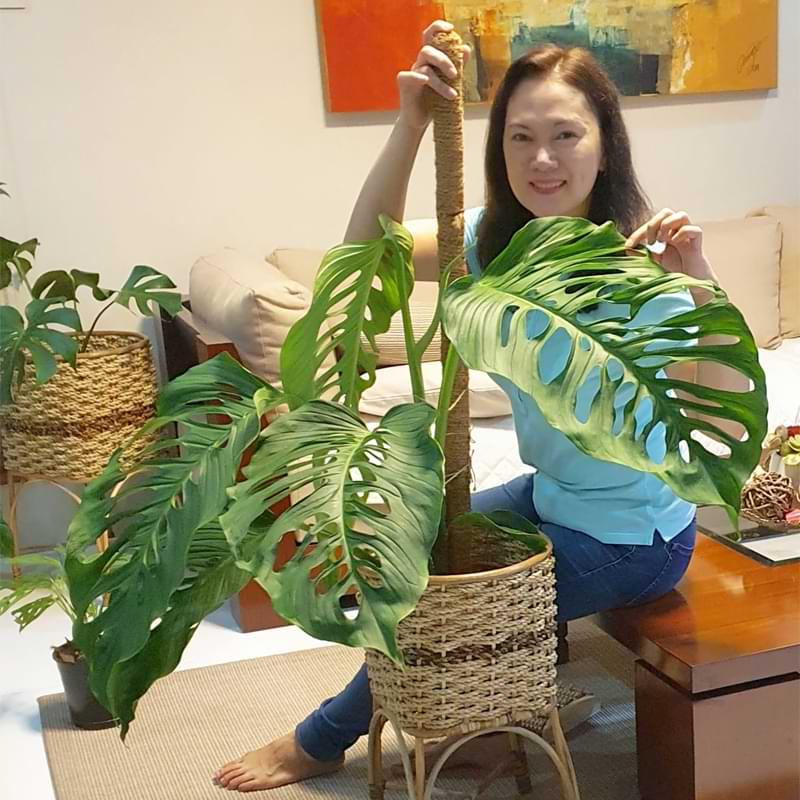Monstera Laniata and Adansonii are two popular choices that can add a touch of tropical flair to any space. However, with their similar appearance, it can be challenging to tell them apart. So let’s dive into everything you need to know about these two beautiful plants so that you can easily identify them and make an informed decision on which one is right for you. Get ready to become a plant expert!
Table of Contents
Monstera Species
There are several different Monstera species, but the most popular varieties are the Monstera deliciosa and the Monstera adansonii. The Monstera deliciosa is a large evergreen vine that can grow up to 20 feet in length. It has leaves that are deeply lobed and have a distinctive split-leaf appearance. The plant produces white flowers that turn into edible fruit. The fruit is often used in salads or as a garnish for other dishes. The Monstera adansonii is a smaller vine that only grows to about 10 feet in length. It has much narrower leaves than the deliciosa and does not produce fruit.
Other species of Monstera include the Monstera Pinnatipartita, which is a small shrub-like plant with very narrow leaves; and the Monstera Standleyana, which is an epiphytic vine that grows on trees in tropical rainforests.
There are several cultivars of Monstera species that have been developed for ornamental purposes, but overall, the Monstera genus includes a wide variety of plants with different growth habits, leaf shapes and sizes, and flower colors. Some species look very similar to each other, and it can be hard to distinguish them, while other Monstera species look almost nothing alike.
While many Monstera species are similar in appearance, there are some key differences that can help you identify them. Since the Laniata and Adansonii are some of the most popular varieties of Monstera’s, let’s dig into the differences between them.
Sub-Species Laniata
The Monstera Laniata plant is actually a subspecies of Monstera Adansonii. So while all Monstera plants are related as you are related to a cousin or sibling, the Laniata is actually much closer than that to the Adansonii. The Laniata is identifiable by its larger, glossy dark green leaves. This plant has the capability to grow larger than the Adansonii, so the leaves tend to be larger also.
Another identifying mark of the Laniata variety is the fenestrations within the leaves. The Laniata variety will have very symmetrical fenestrations.
This variety of Monstera is native to Mexico and Panama, and thrives in warm, humid conditions. It prefers partial to full sun exposure and well-draining soil. With proper care, the Laniata can reach lengths of up to 10 feet or more.
The Laniata is an easy plant to care for and is a great choice for those new to growing Monsteras. Though it is not as tolerant of neglect as some other varieties, it is still relatively low-maintenance and can thrive with only occasional watering and fertilizing. The Laniata also has a vining habit, making it perfect for use as a trailing plant in hanging baskets or as a climbing plant on a trellis or other support.
Is Laniata A Rare Monstera Variety
The Laniata variety is an uncommon variety of Monstera. It is not necessarily rare, but it is less common than some other varieties of Monstera plants. More and more people are beginning to propagate and share or sell their Laniata varieties because they are such beautiful plants, and that is helping this plant become more easily accessible to house plant enthusiasts.
Variegated Laniata’s are in fact rare, and can be quite pricey if you do happen to find one. The variegation in the leaves brings even more beauty to this plant, and many people want one for themselves. However, the variegation also means that the plant isn’t able to synthesize the food that it needs from sunlight as easily as a fully green-leafed plant. This also makes this plant harder to grow and more difficult to keep alive after propagation.
Monstera Laniata Vs Adansonii Differences
The best way to tell the difference between the Laniata and Adansonii Monstera’s are by looking at the plant as a whole, and then the leaves. While at first glance the leaves may seem identical, look closely and you’ll soon see the differences between them.
Plant Size
When it comes to the size of these two plant species, there is a significant difference. The Adansonii typically grows to be about 5 feet tall indoors, but with perfect conditions can grow up to 8 feet tall. The Laniata can grow up to 10 feet tall indoors, and possibly even taller! Of course, this all depends on the growing conditions and soil type. In general, though, the Laniata will definitely be the larger of the two.
Leaves
Leaves are the most important identifying factor when it comes to Monstera plants. The laniata has large, oval-shaped leaves that are deeply lobed and have semi-pointed tips. The adansonii, on the other hand, has much smaller leaves that are more triangular in shape with less defined lobes and a distinct tip at the end.
Another difference between the two types of leaves is their coloration. The Laniata’s leaves are a deep, glossy green, while the Adansonii’s leaves are a lighter green. The Laniata tends to be a fuller plant with more leaves than the Adansonii, also, although this can be difficult to see, and it can change depending on the amount of light and nutrients each plant receives.
Fenestration
Fenestration is one of the main ways to differentiate a Monstera Laniata from an Adansonii. Fenestration refers to the large, oval-shaped holes or windows in the leaves of the plant. The leaves of a Monstera Laniata will have fewer and larger fenestrations than those of an Adansonii. Additionally, the fenestrations on a Monstera laniata will be more evenly spaced out than those of an Adansonii.
So, which type of Monstera is right for you? If you’re looking for a plant with big, bold leaves, then Laniata is the way to go. If you prefer a more delicate look, then Adansonii might be better suited for your taste. No matter which one you choose, you’re sure to end up with a beautiful houseplant!
Monstera Laniata Variegated
If you’re looking for a stunning variegated Monstera, you may be interested in Monstera Laniata variegated. This plant is native to Costa Rica and Panama, and it’s a climbing vine that can reach up to 20 feet in length. The leaves are typically green with white splotches or stripes, some even have an entire half of the leaf that is white! It is a truly stunning variety of the Monstera Laniata, and they have been growing significantly in popularity as they make more and more appearances on social media.
Because variegation is more sought-after, and it makes the plant naturally harder to keep alive, this is one of those varieties that people are charging hundreds of dollars for. Although stunning to look at, it may be worth shopping around for a reputable source before deciding to purchase one.
Other Similar Monstera Varieties
One of the most rare Monstera varieties is actually one that many people mistake for the Adansonii. The Monstera Obliqua looks very similar to the Laniata and Adansonii, and it is one of the most rare varieties of Monstera plants. The easiest way to tell the difference between the Obliqua and an Adansonii or Laniata is the fenestrations in the leaves. The Obliqua will have much larger fenestrations, taking up most of the leaf, whereas the Adansonii and Laniata have more greenery and smaller fenestrations.
Another similar Monstera is the Lechleriana. This variety is naturally found in the same region as the Laniata, but it has adapted to higher elevations and is commonly found climbing up some of the tallest trees in central South America. The leaf clusters of the Lechleriana are also closer together, and it is not as commonly seen as a houseplant.
The Monstera Blanchetii is another variety that looks similar to Laniata’s, but this one is a bit easier to tell apart. The Blanchetii has asymmetrical leaves, and as the plant gets older and more established, the asymmetry does not fade. Mature leaves can have anywhere from 15-30 fenestrations! At a young age, it may be hard to tell the difference between a Blanchetii and a Laniata, but as they grow older it should be very easy to tell these two varieties apart.
All Monstera varieties have similarities between them, making it semi-difficult to easily tell them apart if you aren’t a Monstera expert. But regardless of their differences, every Monstera variety is beautiful and will make for a stunning addition to anyone’s indoor jungle. Hopefully the difference between the Laniata and Adansonii is a bit clearer now that we know the Adansonii is a wider umbrella genus that includes the Laniata variety.
More Monstera Resources
Learn more about caring for these amazing plants!






